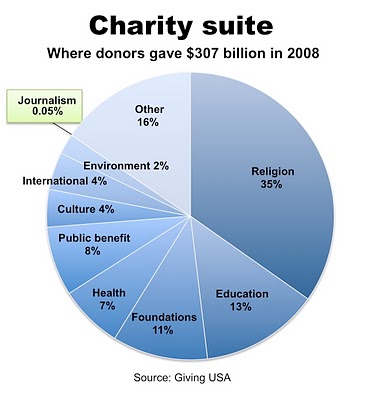
Nonprofits Can’t Possibly Save the News
[Source: Reflections of a Newsosaur, by Alan D. Mutter; March 30, 2010]
An amazing number of smart and sophisticated people continue to harbor the fantasy that philanthropic contributions can take over funding journalism from the media companies that traditionally have supported the press.
In the interest of moving discussions about the endangered outlook for professional journalism back into the realm of realistic thinking, we’re going to do the simple math today to prove conclusively why this never will happen.
The math, as detailed below, shows that it would take $88 billion – or nearly a third of all the $307.7 billion donated to charity in 2008 – to fund the reporting still being done at America’s seriously straitened newspapers.
If you want to cover magazines and commercial broadcasting – not to mention the myriad journalism start-ups responding to the meltdown of the mainstream media – it would take billions more in philanthropic support. But the number is so big and unapproachable that I gave up counting when I saw how comparatively little – $141 million – was raised in the last four years to fund nonprofit news ventures.
To be sure, a few boutique nonprofits like Pro Publica, the Texas Tribune and the Center for Independent Media (recently renamed the American Independent News Network) have been funded generously to date to provide specialized reporting on select topics. But they make no pretense of providing the ongoing and intense beat coverage that historically were the meat-and-potatoes of quality local journalism.
The sharp contraction in recent years in the sales and profitability of for-profit media companies has led to dramatic and traumatic staff reductions in almost every newsroom in the land. As the economy tanked in 2008, even philanthropically supported public broadcasters had to cut staff when contributions declined from not only foundations but also viewers and listeners like you.
Rick Edmonds, the estimable media economics expert at the Poynter Institute, calculated that American newspapers are spending $4.4 billion today on news-gathering, or about 29% less than the $6.2 billion that funded newsrooms as recently as 2006. That’s a drop of $1.8 billion.
If you wanted to sustain the current level of newspaper coverage by replacing for-profit funding with nonprofit dollars, the typical approach would be to raise an endowment that would be invested conservatively to produce an annual return of 5%. The investment income would be distributed each year to provide the operating budgets for nonprofit news organizations.
The endowment necessary to provide $4.4 billion in annual newsroom funding would be $88 billion. This happens to be 29% of the entire $307.7 billion contributed to charity in 2008, according to data published by the Giving USA Foundation, the nonprofit arm of an organization of professional fund-raisers.
Given the downturn in the economy since 2008, it is a safe bet that charitable donations dropped in 2009 and probably will be less than $307 billion in this year, too.
The decline in donations is not the biggest challenge for those counting on charity to rescue the press. The infinitesimal amount of support to date for nonprofit news projects suggests that philanthropists have other long-standing priorities.
As reported recently in the annual State of News Media study by the Pew Project for Excellence in Journalism, Jan Schaffer of the J-Lab at American University estimated that only $141 million (not including public broadcasting) of philanthropic support has gone into nonprofit journalism efforts in the last four years. The sum is less than 0.05% of the $307 billion given to charity in 2008 alone.
In light of the above objective facts, it is clear that there are only two ways to establish a substantial philanthropic base to preserve journalism:
Either (1) vast new sources of charitable funding would have to be identified or (2) existing philanthropists would have to be persuaded to abandon their traditional commitments (see chart below) to religious, educational, social service, cultural, environmental and other organizations.
While there is a pressing need to save the press, a major shift in the philanthropic paradigm seems unlikely, especially in an era in which most folks – with the notable exception of a fortunate few – seem to be tightening their belts.
So, let’s stop dreaming about a visit from the Non-Profit News Bunny and get serious about discovering some realistic possibilities.



